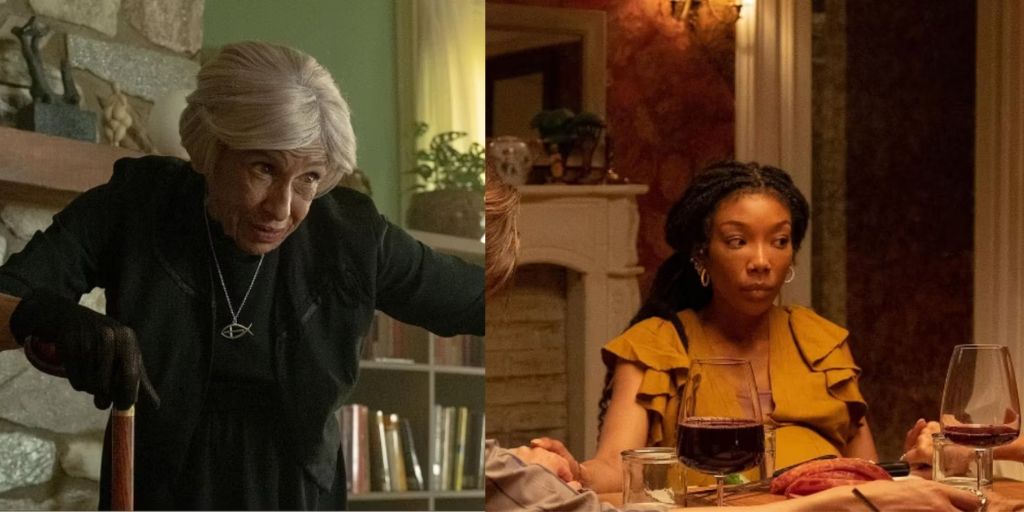You gotta love the in-laws. Or maybe you don’t. Brandy Norwood’s Belinda experiences this firsthand in the new horror film, The Front Room, directed by Max and Sam Eggers.
The film, produced by A24, tells the story of Belinda, an expectant mother whose peaceful life is disrupted when her elderly mother-in-law, Solange (played by Kathryn Hunter), moves in.
As Belinda prepares to give birth, she faces a power struggle with the very religious Solange. This leads to a uniquely comedic and thrilling battle over the future of Belinda’s family and home.
What Is ‘The Front Room’ About?
The Front Room follows Belinda and her husband Norman (played by Andrew Burnap), who are eagerly awaiting the arrival of their second child. This moment of joy is shadowed by the loss of their first child, a tragedy that weighs heavily on their hearts.
Their financial situation adds to the emotional burden of the new arrival. The story takes a turn when Norman’s father passes away, leaving behind a final request: Norman must allow his estranged mother, Solange, to move in with them.
Solange is not an easy guest. She is an elderly woman with a challenging personality, characterized by her incontinence, manipulative behavior, and a deeply religious and racist worldview. Her past relationship with Norman is strained due to her harsh and controlling manner as a stepmother.
Solange believes she is frequently possessed by the Holy Spirit, which adds another layer of complexity to her character. Despite her numerous flaws, she comes with a significant inheritance, which complicates Norman’s decision to refuse her request.

Once Solange moves in, the tension between her and Belinda quickly escalates. The film portrays a dramatic and often darkly comedic conflict over who will have control in the household, with significant stakes for the future of Belinda’s family and their home.
Belinda and Solange Square Off Over Who Gets To Be Matriarch
The central conflict of The Front Room revolves around the power struggle between Belinda and Solange. Norman’s initial reluctance to let Solange live with them is rooted in their troubled past.
As a stepmother, Solange was stern and strict, imposing her rigid version of Christianity on Norman. This upbringing left Norman with deep emotional scars and contributed to his estrangement from his mother.
Solange’s arrival reintroduces her domineering presence into the household. At first, she pretends to respect Belinda’s role as the maternal figure. However, her subtle criticisms soon become more overt.
Solange disapproves of Belinda’s cooking, her interest in Goddess figures, and the lack of Christian symbols in their home. She even criticizes the baby’s name and feeding practices. Belinda becomes increasingly aware of Solange’s attempts to undermine her, leading to a significant clash of wills.
As tensions rise, Belinda finds herself fighting to maintain her place as the matriarch of the family. The conflict is not just about who gets to be the primary mother figure but also about the control and influence over the household.
Solange’s attempts to replace Belinda lead to a dramatic confrontation, with Belinda declaring, “I am her mother!” and Solange retorting, “Oh no ya ain’t!” The battle for maternal dominance intensifies, reflecting the deep-rooted issues between the two women.
Solange’s Supposed Powers Are Likely Fake
Another intriguing aspect of The Front Room is the portrayal of Solange’s supposed supernatural abilities. Solange, who is deeply religious, believes she is often possessed by the Holy Spirit, which she refers to as “signs and wonders.”
Her church community seems to support these beliefs, adding a layer of credibility to her claims. As the conflict with Belinda progresses, Solange’s supposed powers become more pronounced.
After the birth of Belinda’s baby, Laurie, Belinda develops a large, crooked C-section scar. The next morning, the scar appears to improve significantly.
This change, along with other strange occurrences, such as Solange appearing as a Virgin Mary figure holding the baby, leads Belinda to question what is real. Exhausted from sleepless nights and Solange’s intimidating presence, Belinda begins to doubt her own perceptions.
Despite the eerie occurrences, Belinda also notices signs that Solange may be faking her disability and manipulating situations to gain sympathy.
Solange’s walker seems less necessary than she lets on, and Belinda catches her in several deceitful acts. The evidence suggests that Solange’s “powers” are not genuine but rather a result of Belinda’s extreme fatigue and the stress of her situation.
How Does ‘The Front Room’ End?
The mounting tension and Solange’s relentless torment push Belinda to her breaking point. The situation reaches a climax when Belinda discovers a large bite mark on the baby, Laurie, which she suspects is caused by Solange.
The film depicts a night of Solange lamenting her own death, and the next morning, she is found dead. Initially, it seems that Solange died in her sleep, but the film later reveals that Belinda secretly smothered Solange with a pillow.

Belinda’s drastic action underscores the extreme measures she has been driven to by Solange’s behavior. Throughout the film, Belinda is portrayed as a compassionate and caring person, making her act of killing Solange seem like a desperate and justified response.
The film’s conclusion shows Belinda’s life improving dramatically after Solange’s death. She gets a new job, the family’s financial troubles are resolved, and they move into a new house. The film ends on a note of dark humor, suggesting that Belinda’s choice was the right one for her and her family, despite the horrific nature of the act.




